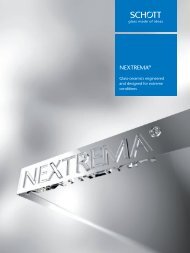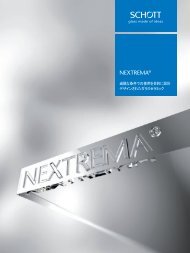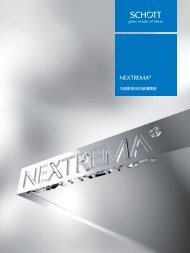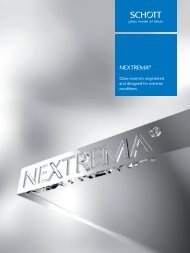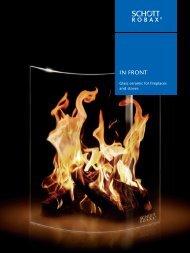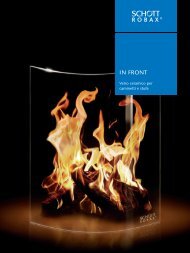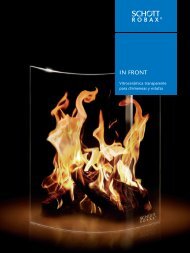SCHOTT Technical Glasses
Apart from its application in optics, glass as a technical material has exerted a formative influence on the development of important technological fields such as chemistry, pharmaceutics, automotive, optics, optoelectronics and information technology. SCHOTT Technical Glasses offers pertinent information in concise form. It contains general information for the determination and evaluation of important glass properties and also informs about specific chemical and physical characteristics and possible applications of the commercial technical glasses produced by SCHOTT. With this brochure, we hope to assist scientists, engineers, and designers in making the appropriate choice and make optimum use of SCHOTT products.
Apart from its application in optics, glass as a technical material has exerted a formative influence on the development of important technological fields such as chemistry, pharmaceutics, automotive, optics, optoelectronics and information technology. SCHOTT Technical Glasses offers pertinent information in concise form. It contains general information for the determination and evaluation of important glass properties and also informs about specific chemical and physical characteristics and possible applications of the commercial technical glasses produced by SCHOTT. With this brochure, we hope to assist scientists, engineers, and designers in making the appropriate choice and make optimum use of SCHOTT products.
You also want an ePaper? Increase the reach of your titles
YUMPU automatically turns print PDFs into web optimized ePapers that Google loves.
18<br />
Sealability<br />
In fusion sealing with other materials, the decisive glass<br />
property is the linear contraction. As Figure 14 shows, the<br />
experimental setting point T E lies in the already sharply bent<br />
section of the glass curve, and the experimental setting<br />
temperature increases with increasing cooling rate. Predicting<br />
the linear contraction is only possible if the shape of<br />
the glass curve and the setting point T E for the respective<br />
cooling rate are known. The stress-optical measurement of<br />
stresses in test fusions with practice-oriented cooling rates<br />
(ISO 4790) is a simpler and much more accurate method<br />
of testing the sealability.<br />
Thermal stresses<br />
Owing to the low thermal conductivity of glass (typically<br />
0.9 – 1.2 W/(m · K) at 90 °C, or a minimum of 0.6 W/(m · K)<br />
for high-lead-containing glasses), temperature changes produce<br />
relatively high temperature differences ΔT between<br />
the surface and the interior, which, depending on the elastic<br />
properties E (Young’s modulus) and µ (Poisson’s ratio), and<br />
on the coefficient of linear thermal expansion α, can result<br />
in stresses<br />
In addition to the geometric factors (shape and wall thickness),<br />
the material properties α, E and µ decisively influence<br />
the thermal strength of glasses subjected to temperature<br />
variations and/or thermal shock. Thermal loads of similar<br />
articles made from different glasses are easily compared by<br />
means of the characteristic material value<br />
φ = σ<br />
ΔT = α E<br />
1 – µ [MPaK–1 ],<br />
which indicates the maximum thermally induced stress to be<br />
expected in a flex-resistant piece of glass for a local temperature<br />
difference of 1 K. Because cracking originates almost<br />
exclusively from the glass surface and is caused there by tensile<br />
stress alone, cooling processes are usually much more<br />
critical than the continuous rapid heating of glass articles.<br />
σ = ΔT α E<br />
(1 – µ) [MPa].<br />
300<br />
Compressive<br />
stress<br />
200<br />
0<br />
Tensile<br />
stress<br />
100 100 MPa<br />
x<br />
a<br />
c<br />
A<br />
B<br />
C<br />
M<br />
b<br />
M<br />
Relative contraction ΔI/I ––><br />
Tg<br />
x<br />
x<br />
0 200 400 600 800 1000<br />
Temperature in K ––><br />
Fig. 11. Stress distribution across the thickness of thermally prestressed<br />
flat glass (a) without, (b) with additional bending M; (c) stress distribution<br />
in bending without prestressing<br />
Fig. 12. Typical thermal expansion – temperature curve for glasses






